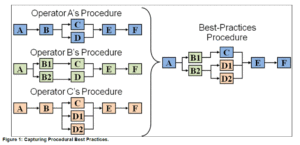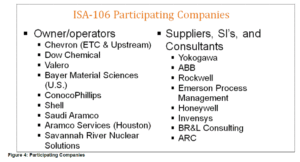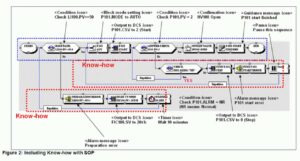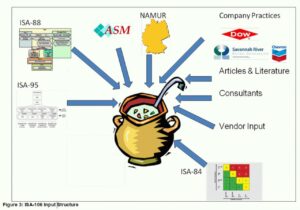History of Modular Procedural Automation
A procedural operation consists of a set of operator tasks that are conducted in a set way time-after-time to achieve a certain goal such as starting or shutting down a unit or making a product. As demonstrated by Paul McKenzie (Bristol Myers Squibb) at the World Batch Forum (WBF) North America conference 2007 in Baltimore, it could even apply to the operation of an analyzer. So how was the journey to modular procedural automation?
If you look back at the functions available to control systems for both programmable logic controllers (PLC) and distributed control systems (DCS), they focused on discrete and continuous control. Sequential and batch control functions were added later and the logic was more complex. Batch processes are procedural in nature, but typically involve sets of procedures running in parallel on varying process units and almost always need to have inbuilt flexibility. The ISA-88 standard ultimately addressed batch automation very well, however, attempts were made in the 1970s and 1980s to implement advanced procedure management using control system functions with strings of function blocks or by straight-line coded applications. These functions certainly could handle the sequential nature of procedure management but they had limitations.
One key area was in messaging and communicating back to the operator. Procedure management and control require a verbose interface but control systems by their nature limit this ability. Therefore, providing limited information to the operator hampered his ability to make procedure decisions, take action on alternatives, and realize the reasons for current process states. Managing a procedure or process transition in automatic mode did not work well and operators chose to accomplish procedure management manually.
Another difficult area to overcome was that most procedure management involves unsteady state operation which includes many manual operations for the field or deck operator. This meant that the skill and knowledge of running the operational procedure stayed with the operators and operations staff and not with the control system designer or engineer. Typically the operations team is not in charge of the control system configuration and engineering.
In the 1990s operator support tools or advanced operator assistance functions began appearing which were independent of the control system. The chemical industry with both continuous and batch processes began implementing procedure automation utilizing these new tools and packages. Procedure and process transition flow charts with steps that guided the operator through complex process changes appeared on operator consoles. By the 2000’s the petrochemical and oil/gas downstream industry took the successes achieved within the chemical industry and began applying similar automatic transition management solutions. Over the last decade, many papers have been published describing the implementations and the results achieved. Now in the 2010s, innovation has begun in the upstream industry where procedure automation is being tested, modeled and deployed on production platforms and within on-shore oil fields.
Transition Management
In its basic definition, transition management is a method of implementing advanced procedure management. The goal is to improve overall performance through faster and smoother transitions. This contributes to extended equipment life and optimized production or product yield. There are three broad operational procedures involving transitions: startup, shutdown and unit state change. The unit state change includes transitions like grade changes, production rate changes, process equipment switches, etc. Transition management applies equally to a complete process unit and to a selected piece of equipment in a processing unit, like a shutdown valve, or a test separator or a heat exchanger. Transitions also inherently increase the risk of disruptions that can lead to incidents or lost production. According to a report by the insurance company Marsh Ltd, over the period 1975-2009, the 5-year loss rate (adjusted for inflation) in the refinery industry continued to rise. Incidents that occurred during startup and shutdown continued to be a major factor. An additional study by J&H Marsh and McLennan showed that examination of major incidents by the average loss per incident indicated that operational error caused the largest average dollar loss.
A fourth area that is added to transition management is “abnormal” process state changes, like a process trip resulting in a well shutdown or a larger event causing a platform shutdown. In some abnormal transitions, like a process trip, most of the time there is an opportunity for a process operator to reset the equipment and operating conditions to reestablish normal conditions. The goal is to minimize production rate disruption. But the time window is narrow and is very challenging to do during an abnormal event and most often the affected process is brought to a much longer shutdown state with the result of higher production losses.
These four categories of transition management which have been well known for the last 20 years in other industries, most certainly apply to the upstream industry. In the last two years, another category of procedural operations has become more important involving a significant amount of time for the upstream operator. These are safety and compliance testing procedures in the upstream industry.
Capturing Procedural Knowledge
Together the five areas mentioned above are the places for implementing advanced procedure automation integrated into the operator’s console. The existing paper-based operator procedure library and standard operating procedure (SOP) manuals contain the “static” knowledge known when the production platform was being built and brought on-line. The actual procedural knowledge and skill are in the heads of the most experienced operators. However, knowledge and the accompanying skill sets are leaving the workplace due to retirement, and the availability of good operators to run these procedures manually is diminishing. How to preserve the knowledge of the best operators on his/her best day has become the question. Modular Procedural Automation (MPA) can help to facilitate the process of capturing the knowledge of these skilled employees before they retire or are laid off as recent research has shown that up to 42 percent of all corporate knowledge is actually stored in employee’s brains. As many firms continue to operate with lean technical staff, yet the level of technological complexity is increasing, the timely flow of information, data, and knowledge is more important than ever in the process industries. This downward trend in staffing and the increased demand for accurate, real-time information will translate into additional systems and higher, more sophisticated levels of automation being applied, including Modular Procedural Automation. The smaller, less experienced workforce that will exist in the future must be empowered with new technologies and workflows that can transfer knowledge on demand.
Figure 1, below, depicts the methodology of capturing procedural best practices. The goal of this approach is to “distill” best-operating practices and find the right balance between manual, prompted and automated procedures, documenting and implementing the procedures and then executing continuous improvement cycles on them. Automating every procedure does not always provide the best solution; neither does manually executing every procedure. What does provide the best solution is to consciously examine events that caused production interruptions, then examine the procedural operations associated with those events, document them and determine what type of implementation will provide the best economic return while improving safety, health and the environmental metrics for the facility.

A modular procedure consists of steps and as shown in Figure 1, each operator has started with the SOP but has modified it to handle different situations and styles of operating by adding additional steps. On the right-hand side is the resultant “best-practice” procedure.
Another example of capturing procedural best practices is shown in figure 2. The original SOP was simply:
1. Check base tank level LI100.PV>=50%
2. Start pump P-101 after correct suction header pressure is confirmed
3. Check answer back flag
4. Confirm deck operator opened hand valve HV100
However, after evaluation and consultation with operation teams, the best practice, “know-how”, was added to the initial SOP flow chart. This is shown pictorially within the red, dotted boxes. The SOPs are updated and converted into an electronic-based procedure. Procedure documentation can then be readily available to the operator and is a living document. Procedure execution is documented, recorded and reported automatically. A global standard with best practice is developed and deployed. This increases knowledge-sharing and synergies across the upstream enterprise.
Procedural Operations
The upstream facilities are run and maintained according to operational procedures and every process and transition has a documented SOP. A procedure consists of a set of tasks that are conducted in a set way to achieve a certain goal. Procedures vary by type of installation/company/location, but they require consistent execution. There are three main types of procedures: manual, prompted and automated.
1. Manual
Manual procedures are performed by operators taking actions either in the control room or in the field. Often operators perform these procedures based upon their training and experience gained over the years and upon reference to written documents such as SOPs. There can be considerable variability in performing manual procedures as some operators or shifts often have better skills or more experience. Documentation for process improvement or compliance requires manual records which can vary in quality and be difficult to gain benefits from without additional data analysis.
2. Prompted
Prompted procedures are implemented in a control or manufacturing execution system which steps through the procedures, stopping at the end of each step or action and waiting for the operator to manually grant permission to continue. Prompted procedures can decrease variability, transition times and enable automatic record keeping.
3. Automated
Automated procedures are implemented in control systems and generally only stop at the end of normal operational sequences. If an abnormal situation takes place or an operator intervenes, the sequence can be held or perform exception handling. Automated procedures can provide an improvement over prompted procedures yielding further improvements in variability and transition time reduction.
Applications Targets for Upstream Procedure Automation
Typical facilities that merit automated procedural operations are the offshore production platform and the floating production, storage and offloading vessel (FPSO) because of the concentration of processing in critical environments. These are used by the offshore industry for the processing and storage of oil and gas. The FPSO vessel is designed to receive oil or gas produced from nearby platforms or subsea wells, process it and store it until oil or gas can be offloaded onto a tanker or transported through a pipeline. As is typical in these applications, safety, and spill performance are paramount in the matrix calculation of operational cost. The actual risk of safety events and spill occurrences are kept very low because the consequences of any excursion are huge.
The oil and gas fields onshore also have complex procedural operations. Secondary and tertiary oil recovery methods follow procedures that are very repetitive but need constant vigilance to maintain costs and maximize production rates. A typical example is steam flooding in an oil field or in steam-assisted gravity drainage (SAGD) oil fields. In the U.S. hydraulic “fracking” to extract natural gas has been practiced since the 1940s. Only today is the economy and technology available to begin the extraction of natural gas in large underground fields. However, procedural operations are again paramount in maintaining facility performance and environmental standards.
Natural gas fields along with gas pipelines lead to processing facilities called liquefied natural gas (LNG) plants and gas to liquids facilities (GTL). LNG is a clear, colorless, nontoxic liquid that forms when natural gas is cooled to around -160 DegC. This shrinks the volume of the gas 600 times, making it easier to store and transport. The required chemistry is basic but the complexity arises from the extreme temperatures and required high pressures. In addition, each gas field brings different challenges. For example, the natural gas quality determines how much pretreating and energy will be required to make an LNG product to specification before transport. Typical items of concern are water, acid gases, sulfur compounds, carbon dioxide, heavier hydrocarbons, and heavy metals. Automating procedural operations help reach maximum performance in the five areas mentioned above but also in maintaining equipment life.
Some of the events challenging the upstream industry today are rising operating costs and tougher extraction of oil and gas due to rising complexity. Risk has always been a constant but what has changed today are the consequences from trips, flaring and venting. In the last two years, when shutdowns are attributed to failing to follow the procedure, then procedure automation is implemented. Common examples of modular procedural automation are in the following areas: well flow lines and test separators, regulatory compliance in emergency shutdown (ESD) checks, and temperature safety checks, subsea compliance communication checks, ramping-up of wells, recovery from unit trips minimizing spillage and flaring, and advanced transition management to improve equipment life.
Procedural operations are now being used in the Gulf of Mexico for compliance testing. U.S. government regulations have tightened up considerably and now it’s not only important to demonstrate that you have a procedure but are actually following it and further can prove you are following it.
In 2009 Shell developed automated procedures in an LNG facility to stem losses from transition management. In this case, after a shutdown or trip, the cool-down procedure for the main cryogenic heat exchangers (MCHEs) was used to achieve a predefined temperature profile. Before automation the procedure was always a manual operation because it involved a complex set of steps, the process responded non-linearly during cool-down and operators needed to handle several actions simultaneously. The objective was to eliminate equipment failure (leaks) due to exceeding recommended levels in the rate of cooling. These costs could amount to 2% of annual production. Development of automated procedures took into account operator experience (capturing best-practices), analyses of existing procedures and historical data. The implementation was constructed of modules performing specific tasks and procedures.
Modularizing Procedural Operations
Procedural automation has been a consistent goal in most of the processing industries for several decades. It increases safety and reliability and provides consistent, repeatable and verifiable procedural operations. It also maintains the primary role of the operator.
Automated procedures for continuous processes in the past have typically been implemented using ad-hoc designs and programming techniques usually resulting in difficult-to-maintain code. While this can provide short-term operational benefits, the total cost of ownership of these procedures is higher than necessary. This is due to the increased implementation costs to change and update successive procedures over time due to the lack of reusable software modules.
With the modularization approach, procedures are constructed like “building blocks”. This improves flexibility and standardization while reducing engineering and maintenance costs. Implementing a modular approach could also provide companies with the ability to standardize functions across plants, sites, and the global enterprise, achieving corporate-wide repeatability and reproducibility. This would help reduce engineering labor costs, provide consistent operations, and lower the Total Cost of Ownership (TCO).
Modular Procedural Automation (MPA)
MPA is a consultative methodology whose purpose is to document and automate procedural operations in continuous processes. A modular design approach facilitates standardized implementation within sites and across companies. This approach optimizes user acceptance and reduces deployment costs.
Using a modular approach as offered by MPA provides a number of benefits such as:
- Hierarchy of Procedures: MPA breaks large and complex procedures into smaller modules and organizes them into a hierarchy. This modularization provides easier documentation, verification, and implementation of the discrete pieces of procedural logic and knowledge.
- Re-use of Procedural Logic: Whether implemented with manual, prompted, or automated procedures, MPA can help re-use the same procedures and logic in different parts of the plant and with different products. When procedural logic (that is portions or modules of procedures) is re-used, business gains repeatability, reliability, and it lowers the cost of developing duplicate procedures.
- Multi-site Consistency: Companies with multiple production sites can experience an efficiency gain and product improvement by standardizing procedural knowledge between plants. Without modular procedural automation techniques, this level of standardization would be very cumbersome to maintain. Modular procedures, both prompted and automated, allow easy sharing of procedural knowledge between facilities.
- Scalable Approach: MPA provides a flexible and scalable approach to automation; it avoids the “one size fits all” approach. Different types of procedure implementations contain scalability for manual, prompted, and automated control. The hierarchy of modular procedures is easily adjusted to fit the application requirements which can vary with the level of complexity (e.g. normal sequencing only or complex exception handling).
- Utilizing the Best Toolset Depending on Requirements: Although there may already be an installed base with existing control capability in a plant, using the MPA methodology the procedure requirements are first understood and documented, and then the best tool for automated procedure execution is recommended.
ISA-106 Standards Committee
Due to the need for a procedural automation industry standard, the ISA (International Society of Automation) approved the formation of a new committee in April 2010, and it adopted the title “Procedural Automation for Continuous Process Operations”. At the first meeting in June 2010, the committee agreed that its purpose was to develop standards, recommended best-practices and to publish technical reports on the lifecycle of automated procedures for continuous process industries. (See figure 3)
Since that first meeting, the committee has grown in size substantially, met face to face several times and held monthly teleconferences. The committee has input and support from 39 manufacturers and suppliers including many energy companies that run refining, petrochemical and upstream operations. (See figure 4)
The initial goal is to publish a technical report based on good practices that are used today. The first draft was issued in May 2011, has gone through a thorough review and will be re-issued in January 2012. Following that, the committee plans to refine the material and hopes to publish a standard.

The topics being considered for the standard are:
• Models and terminology
• Modularization of procedural steps to foster re-use and lower TCO
• State models for procedural logic
• Process unit orientation with an operational perspective
• Exception handling of abnormal process conditions
• Implementation of startup, shutdown, abnormal conditions, hold states, and transition logic
• Recommended target platforms (i.e. basic process control systems vs. safety control systems) for different types of procedures
• Training and certification best practices
Conclusions
The work already achieved in other processing industries has proven the value of standardizing and automating procedures. It covers the sharing of operational knowledge and experience, the implementing of procedure consistency, and the use of modular implementation. Modular procedure automation reduces engineering costs, improves flexibility and reduces downtime for changes. In the last two years, this work is now being applied to the upstream industry and particularly to off-shore production platforms.
Since the upstream sites are geographically dispersed and difficult to reach, innovation has occurred in the area of using remote operation centers (in an offline mode) together with production platform models and virtual basic process control systems. This facilitates the development, testing, and verification of the “best-practice” automation procedures. Deployment to the actual remote upstream site then happens quickly and safely.
Upstream automation procedures are helping reduce costs, improve regulatory compliance, and improve the facilities’ performance by
- Improving safety performance
- Improving spill performance
- Improving OPex/BBL
- Improving daily production






